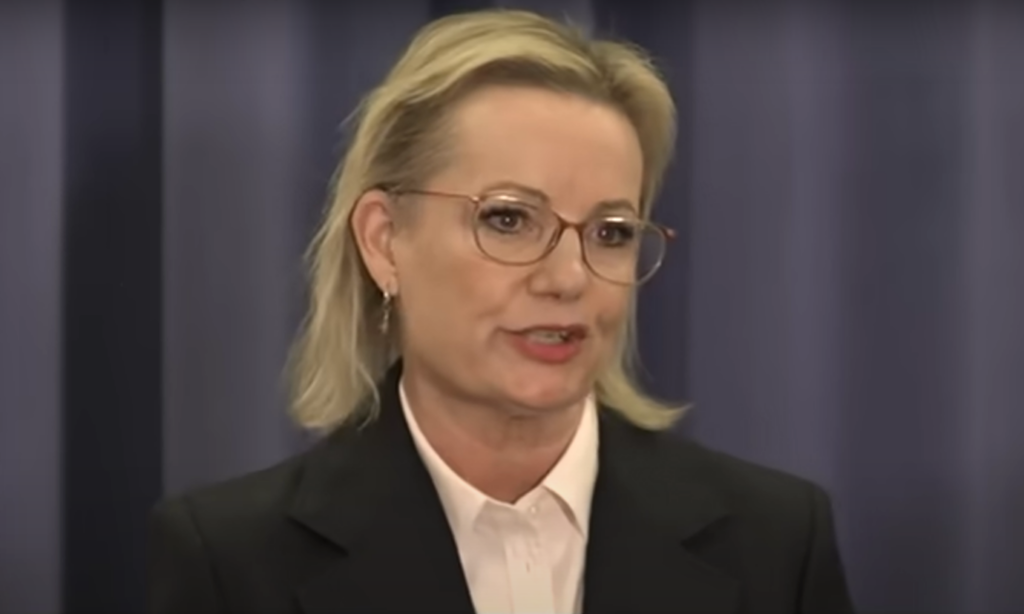Sussan Ley has made history as the first woman to lead the shattered federal Liberal Party but this is no giant leap for womenkind. Ley’s appointment may be significant symbolically (like the additional ‘s’ in her name) but symbols are not systems, and they certainly will not save the Liberal Party.
Ley’s elevation breaks no glass ceiling and represents mere window dressing for the fundamental issues at the core of the Liberal Party’s enduring and chronic gender representation crisis.
Sixty-three-year-old Ley, a former environment and health minister, was the Liberal party’s deputy leader under Dutton and has been a member of parliament since 2001. She now holds the title of the most senior woman in the party’s 80-year history and ascends to the role with a wafer-thin winning margin over Angus Taylor (29 to 25 in favour of Ley). This margin in itself is problematic, exposing the deep party room division which Ley will need to manage internally while undertaking the gargantuan business of rebuilding the very broken Liberal Party at large.
But one of Ley’s greatest problems to solve will be trying to turn the public tide toward Liberal again. According to the Australian National University’s election study, women voting for the Coalition has fallen from 45 per cent in 2013 to just 33 per cent at this year’s election, and a record low primary vote has seen the Liberal Party obliterated by a rising tide of red and teal in the nation’s cities.
The remaining party faithful stragglers and rusted-on stalwarts of the legacy membership base are still (unsurprisingly) mainly old, mainly pale, mainly stale and very male types. Which means that this crusty contingent will most certainly be of absolutely no help to Ley as she begins trying to rebuild the party from a centrist position designed to win back the huge (and significantly women) voter base they’ve lost.
The problem is that by picking up the mantle to rebuild, the Liberal Party’s “women’s problem”—both inside and outside—becomes Ley’s.
In her first press conference as Liberal leader she said “I want to talk about my views of the Liberal party, because the Liberal party has shaped the person that I am today”.
Which is to say that she has largely had to shape herself inside a strongman ‘boys’ club’ party that has been systematically side-lining and failing women for decades, and that has seen Ley long outnumbered by her male counterparts.
Ley needs to now shape her leadership inside a Liberal Party that is in shockingly bad shape, and if it cannot address its concurrent identity and gender representation crisis, its future as a political party may be over.
To be fair, there have been sporadic and tokenistic efforts to recruit and retain women in the Liberal Party — who remembers former Prime Minister Malcom Turnbull’s 2016 rousing “women hold up half the sky” speech? Under Turnbull’s leadership, the party did also sign up to a “gender diversity plan” to increase female representation to 50 per cent by 2025.
But here we are in 2025, and the Liberal Party’s record on women in leadership remains staggeringly thin. Until Ley, no woman has ever served as Prime Minister or full-term party leader. In 2018, there was a moment when we thought Julie Bishop may come close but instead she was thoroughly spurned by her own Liberal colleagues. Bishop received only 11 out of a possible 85 votes in the party room after 10 long years as deputy. No wonder she walked when her party baulked.
And who could forget the treatment of Julia Banks, who quit the party after witnessing a culture of bullying and exclusion? Or the shameful handling of Brittany Higgins’ rape allegations, which triggered a national movement and damning review of federal parliament revealing a ‘boys’ club’ culture of ‘bullying, sexual harassment and sexual assault’ which alas registered barely a blip in actual party reform.
Let us not forget that the Liberal party is also the place where women like Linda Reynolds and Marise Payne were routinely sidelined when it mattered. A party where promising young female candidates are often parachuted into unwinnable seats while their blue-suited male counterparts are groomed for certain success. A party where quotas are still taboo, “merit” remains the fig leaf for inertia and beneath the surface, gender is still at dark and insidious play.
As Julia Gillard said in 2013: “(Gender) doesn’t explain everything, it doesn’t explain nothing, it explains some things. And it is for the nation to think in a sophisticated way about those shades of grey.”
It’s not that there are no talented Liberal women (or future Liberal women politicians in the wings). The problem is the pipeline is broken, the internal culture is boysy and calcified and the Liberal Party playbook hasn’t really changed since John Howard. Reminder that this is the Howard who did not believe in quotas, and in 2016 said he did not think a 50/50 party gender balance could be achieved: “It is a fact of society that women play a significantly greater part of fulfilling the caring role in our communities, which inevitably places some limits on their capacity”.
Ironically, it would now seem that it’s the Liberal Party which continues to place limits on its own capacity — to modernise, transform and wake up to the fact that half the voting population are women.
In a recent article Kos Samaras said: “(The Liberals are) still speaking to a version of Australia that no longer exists, while ignoring the realities, identities and aspirations of the people who will determine its electoral future. Unless it redefines who it is, who it speaks for and what kind of Australia it wants to shape, it will remain locked out of the suburbs, cities and communities where the country’s future is being written.”
Achieving gender balance in our parties and our politics matters not just for equity, but for the effective functioning of representative democracy which will determine our future. Despite the fact that the 48th parliament will feature more women than ever before, men still outnumber women in Australian politics and party rooms. So we need more than symbolism from the Liberals. We need more than Sussan Ley. We need a Liberal Party that doesn’t just tolerate women but values them; that takes proactive measures to promote inclusivity; and that doesn’t just promote one woman in the midst of a political death spiral but commits to building a bench of future leaders from the ground up.
The stakes are too high for half-measures because if the Liberal Party won’t evolve, it won’t just lose women – it will lose (even more) relevance.
Evolving will require seeing the shades of grey that colour our politics and our parliament. Evolving will require quotas, whether the party likes it or not. Evolving will require male leaders to make room for women, and to call out their peers when needs be. And it will also require a cultural audit as rigorous as any fiscal one.
Until then, Ley may find herself leading a party that still sees women as outliers or anomalies rather than political equals. That’s not leadership. That’s just lip service. And that won’t save the Liberal Party either.
Support Women’s Agenda! We are 100% independent and women-owned. We’re covering the Federal Election from the perspective of what matters to women, and always keeping the issues that matter for women on the daily agenda. Foundation memberships are just $5 a month.
Bonus: you’ll receive our weekly editor’s wrap of the key stories to know every Saturday.


